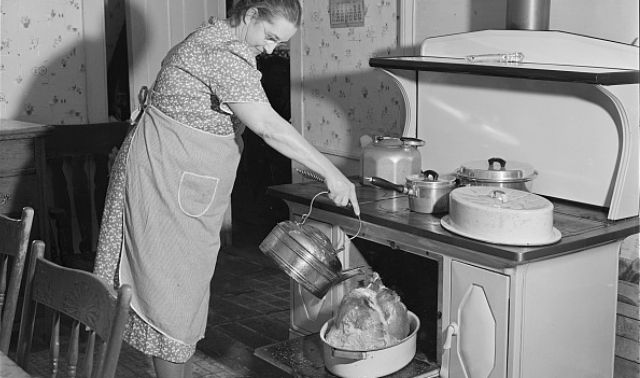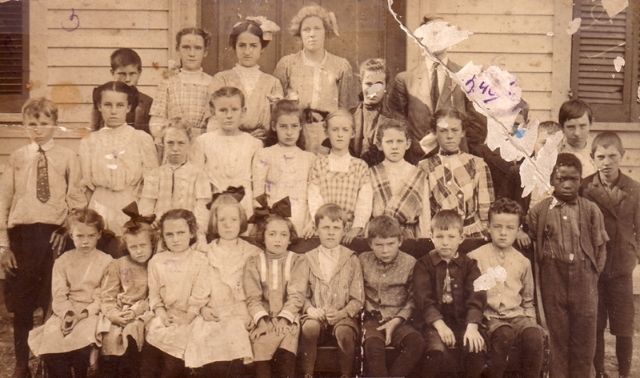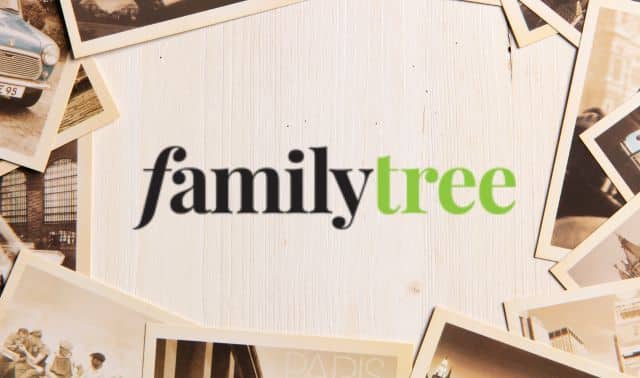Sign up for the Family Tree Newsletter! Plus, you’ll receive our 10 Essential Genealogy Research Forms PDF as a special thank you.
Get Your Free Genealogy Forms
"*" indicates required fields

In addition to being a regular Family Tree Magazine column, Photo Detective was also a long-running blog hosted on our website by Maureen A. Taylor for several years. Here, we’ve combined some of her best posts from the past.
How to Date Old Photos Using Clues Under the Christmas Tree
There are heaps of clues in this charming old picture of two children admiring their Christmas tree (see below). It’s an image from the Library of Congress, whose cataloging record dates it to between 1910 and 1935. That’s a pretty big 25-year time frame.
Can you spot the clues in the picture below? They include:
- tree ornaments and trimmings
- children’s clothing
- vintage train set
- household decorations

1. Tree Trimmings

The glass tree topper in this picture looks a lot like the one my mother always put on our tree. F.W. Woolworth‘s led the American market by first selling glass ornaments made in Germany and later, ones made in the United States. There is a good chance your ancestors bought their tree trimmings at Woolworth’s.
Tinsel has a long history that dates back to Germany in 1610. By the 20th century, artificial, aluminum-based tree trimmings had replaced natural garland made from cranberries and popcorn. Some were lead-based. The FDA didn’t restrict the sales of lead-based tree materials until 1971.
2. Clothing

Bobbed hairstyles for girls became popular about 1915 and remained in style throughout the estimated time frame for this picture. Dropped-waist dresses for little girls debuted at about the same time, but this outfit has a scalloped hemline. Those were common in the early 1920s.
3. Vintage Train Set

A whole village with “snow”-frosted foliage rests under this tree. It’s an electric train set with real street lights. It could belong to the children’s father or be a gift for the Christmas shown.
If you have a toy train collector in your family, show him or her this photo and let’s see if they can date the era of this set. The National Toy Train Museum is another resource.
4. Household Decor
Similar household decorations could be found in the Sears Catalog, which is digitized on Ancestry.com. (I’ll look there for the train, too.) Dating photos based household items is difficult, because families would keep themse items for years. The rug in this house is well-worn with a big spot near the train track, so the curtains and carpet also could be several years old.
Dating this picture relies on all the clues. The train could be key.
Count The Clues in Your Own Images
This image is a good example of how to break a picture down into clues. Establishing the dates for specific clues will not only help you verify the time frame for a picture, it’ll also help you tell a holiday tale.
The History of Photos with Santa

Q: What’s the history of having your picture taken with Santa?
These iconic kid pictures are in a lot of family albums, and judging from the lines at mall Santas, having a photo with this Christmas symbol remains popular.
But when did the first kid have a picture taken with Santa? It’s a good question.
Out on a gift-buying journey I found a cute little book, A Century of Christmas Memories, 1900-1999 by the editors of the Peter Pauper Press (Peter Pauper Press). In it is a picture of baseball great Babe Ruth playing Santa at a benefit in December 1947.
The photo featured above was taken in 1942 at Macy’s Department Store in New York, and now is in the collection of the Library of Congress. Accompanying information mentions there were two Santas, concealed from one another, so that the children wouldn’t be upset. Each child got to talk with Santa and received a piece of candy.
The tradition must be older than that. I turned to Google for help. Some sites say that the first department store Santa was at R.H. Macy’s in New York in 1870, but it didn’t mention photographs. There are also claims of the first department store Santa being played by dry goods owner James Edgar in Boston in 1890.
On Grunge.com, there’s a short article on mall Santas. According to that piece, in 1841, a Philadelphia store featured a life-size Santa model.
I thought a newspaper search might help. I didn’t find exactly what I was looking for, but I did locate an obituary for Charles W. Howard, who was considered the “Nation’s No. 1 Santa Claus.” According to the obituary in the May 2, 1966, New York Times, Howard began his career as Santa when just a child, and then in 1937, he opened a school for Santas. He taught “psychology, costuming, makeup, whisker grooming, voice-modulation and ho-ho-ho-ing.”
Howard said “You’ve got to know the character you’re playing. It’s so real to me sometimes that I can feel the reindeer breathing on my cheek.”
Solving Christmas Photo Mysteries
Library of Congress Photo
This little gem of a holiday picture comes from the Library of Congress collection. Researching the clues in this picture took a little time and involved studying the caption, the history of the image and the clues in photo. It’s a lot more than a holiday-themed image. This one picture tells the story of a family’s charity in a very wealthy community. It’s the perfect Christmas story.

The best place to start untangling the clues was the caption: “LYNDHURST—A Happy Christmas at “Woody Crest,” December 1905. Copyright 1906 by Underwood & Underwood.”
This picture is half of a stereograph: two nearly identical photographs mounted side-by-side on cardstock. Viewing it through a stereopticon makes the image appear three-dimensional.
Ben Underwood and his older brother Elmer were just 18 and 20 years old when they established their stereo view company, Underwood and Underwood, in 1880. Within a few years they had offices in Baltimore and Liverpool, England. According to Stereo Views by William Culp Darrah (Times and News Publishing), by 1901 the pair produced more than 7 million cards per year. They revolutionized the sale of cards by producing them in sets.
Lyndhurst
A quick Google search for Lyndhurst led me to a page about the house of that name in Tarrytown, NY. You can see gorgeous images of this Gothic Revival style estate and read about it’s history.
The Library of Congress cataloging record said the image was taken at the Lyndhurst School. There was no mention of the school on the site for the estate, so further research was necessary.
Only three families owned the house before it was donated to the National Trust for Historic Preservation in 1961. “Lyndhurst” was likely a keyword chosen by the Underwoods to draw attention to the image. The public was fascinated by the lives of these incredibly wealthy individuals.
In 1905, Miss Helen Miller Gould owned Lyndhurst. Her father was Jay Gould, a railroad entrepreneur who had a reputation as a robber baron profiting off the less fortunate. He made millions. His daughter, one of six children, was a very wealthy young woman. Helen briefly attended law school but decided against a public life. Instead, she focused on philanthropy.
Helen Miller Gould and Woody Crest
Helen cared for and educated poor crippled children from the inner city at Woody Crest, a home at Irvington-on-Hudson, New York. She had a reputation as a caring and intelligent woman. Volume 25 of Munsey’s Magazine (April to September 1901) featured a story on her charitable pursuits.

Every year at Christmas she provided a turkey dinner for Woody Crest residents. Dec. 25, 1905, the children turned the tables on their hostess and cooked her a dinner from food produced on the estate. They gave her a gift of a holly and evergreen wreath. You can see her presents to the boys in this picture.
She gave each of the 16 boys at Woody Crest a chest of “tools,” a miniature store, books, and Indian and police costumes. A Dec. 26, 1905, article in the Baltimore American reported details of the event in “Helen Gould’s Boys.” The writer compared her generosity to that of John D. Rockefeller. While he gave telephone and telegraph operators in Tarrytown $5 each, Gould gave them $10 each.
The center image shows off the paper bell hanging from the chandelier, the glass ornaments and trimmings on the tree.
Even Helen Gould’s millions had limits. In 1908, she had to decide which projects to continue. According to the Grand Forks Daily Herald, April 5, 1908, in “Helen Retrenches,” it was reported that she was going to stop summer outings for poor children at Woody Crest.

In 1913 at 45, Helen Miller Gould married Finley Johnson Shepard. The couple adopted three children, one of whom was a baby abandoned on the steps of St. Patrick’s Cathedral in New York, and had one foster child.
It’s a heartwarming story just in time for the holidays.
Family Photo
A photo mystery is the sum total of its clues, whether those hints come in the form of photographic technology, props or fashions. All of these elements are important to unraveling the story behind this holiday image.
Genealogist Tim Doyle has a whopping 11,000 family pictures, a collection of images he inherited from his four great-grandparents. As a youngster, he’d sit with them identifying the photographs, but some remain a puzzle. This picture, offering a peek at a family Christmas celebration, is just one of the mysteries.

PHOTO CLUES
- According to The Encyclopedia of Nineteenth Century Photography (Routledge), several patents were issued in the 1890s for devices to artificially light a photo. The lighting focused on the group clearly shows that the photographer used “flash” photography.
- It’s always useful to examine walls and furniture in the background for framed family images. Unfortunately, the framed items here are only partially visible.
- The young woman wears a light-colored dress with a wide yoke, high collar and full sleeves. The older woman wears a short jacket over her dress. Both styles date from about 1905.
- The man standing is formally dressed in a suit with a high-collared shirt. He sports a a neatly trimmed mustache and glasses. The older man is in work clothes—a tab-collared shirt and casual trousers with a vest and jacket. Both are typical for the first decade of the 1900s.
- Visible beneath the small tree are ferns, a standard houseplant in the Victorian home. The tree may be propped up on a table. Decorations include an angel topper and paper flower ornaments.
- The same flower ornaments are strung across the room and attached to the curtains. Stores sold paper flowers, and directions for making them appeared in popular books such as Flora E. Manchester’s Paper Flower Making: A Kindergarten Occupation for Girls and Infants (1901). This could be a clue to someone’s hobby or occupation.
Christmas trees weren’t part of American holiday festivities until after the 1840s, when German and English immigrants brought the tradition with them to the United States. Ornaments became popular after Woolworth’s sold German-manufactured ones in 1880. Within a decade, tree-trimming had become a $25 million industry.
In her book Encyclopedia of Christmas (Omnigraphics), Tanya Gulevich writes that President Teddy Roosevelt worried about the environmental impact of Americans using so many Christmas trees. He refused to decorate one at the White House until reassured that America’s forests could withstand the annual felling of evergreens.
The decorations in Doyle’s photograph suggest it was taken during the holiday season, but what he really wants to know is the identities of the people pictured. Doyle hopes the two seated, older individuals are Nathaniel Chandler Allen (1822-1887) and his wife Emeline S. (Johnson) Allen (1844-1920) of Willow Bend, Ill.
Based on the clues outlined above, including the clothing and use of flash photography, this photograph was taken about 1905—ruling out Doyle’s tentative identity for the older man.
Estimating ages in a photo can be difficult for several reasons: The pace at which a person appears to age can vary, and the person’s pose and distance from the camera can disguise his or her real age. Finally, an illness can prematurely age a subject’s appearance. The woman in the back could be in her late teens or early 20s. The age of the man standing next to her is harder to estimate, but I can tell he has no gray in his mustache or hair. Although this photo likely shows a family grouping with parents or grandparents in the front, it’s unclear how the two people standing in the back are related.
The names of these folks have so far proven elusive for Doyle, but with so many photographs in his family collection, he may have another, already-identified image of one of these folks. Finding such a picture could be the clue to unlocking their identities.
A version of this article appeared in the December 2014 issue of Family Tree Magazine.
Old Christmas Photos from Readers

The child is Elsie Marion Quakenbush (born 1908). She’s posed with her mother Ella Baird Quakenbush and her father, Alfred Garfield Quakenbush. On the back it says “To Grandma with love from us all don’t fail to see Elsie’s baby doll it looks just like a baby.”
It is pretty life-like. It looks like Elsie also received a book “Sing a Song of Sixpence” and a tea set. Her parent’s are proudly posed with a new Victrola so perhaps that was their Christmas present. Elsie looks about 6 or 7.
Kim thinks that Alfred’s brother George Willis Quackenbush took the photo. He was a photographer in Oxford, New York.
Family Tree Magazine reader Carol N. submitted an image of her parent’s Bill and Cita Jacobs.
They are sitting under the tree at Cita’s parents home in Hartford, Connecticut. The Jacobs were still newlyweds. They were married three months prior to Christmas.

His sister Alma sits next to him. She’s hugging a china faced doll. The other boy and girl are the Bough’s who were the photographer’s children. It was taken in Ringsted, Iowa.
Christmas Tree Photos and Ornaments as Family History
Every year I photograph our Christmas tree. I know I’m not alone. So why do I do it? It captures a piece of my family history. A Christmas tree is a holiday symbol but it’s also a family history treasure.
Each one of the ornaments on my tree has a memory attached to it. From the yarn ornaments I made for my first tree to the ones passed down from my mother to me. I haven’t recorded the history of those ornaments yet, but I should. The New York Times featured a story about a woman who’d collected three thousand ornaments. They represent her life story.
The Wright Brothers’ Christmas Tree
In 1900 the Wright brothers—Orville and Wilbur—photographed their family tree.

This image lets us peek into a turn of the century holiday. The neatly wrapped presents under the tree and a little girls doll in a stroller.
The ornaments are a mix of hand-made and store bought. There is no artificial trim visible, instead someone patiently strung popcorn to decorate the boughs.
As you pack away the ornaments, think about including a note on acid and lignin free paper that tells the history of that item.
These interior photos also show us how our ancestors lived. The Wright brothers liked bold wallpaper on their walls but also their ceiling. In the center of the ceiling is a lovely gas chandelier. It’s a pretty typical Victorian scene from the decorations on the tree to the style of rug on the floor.
Before you take down the tree, snap a picture of it so that later generations can see what Christmas (and your home decor!) was like in your time.










